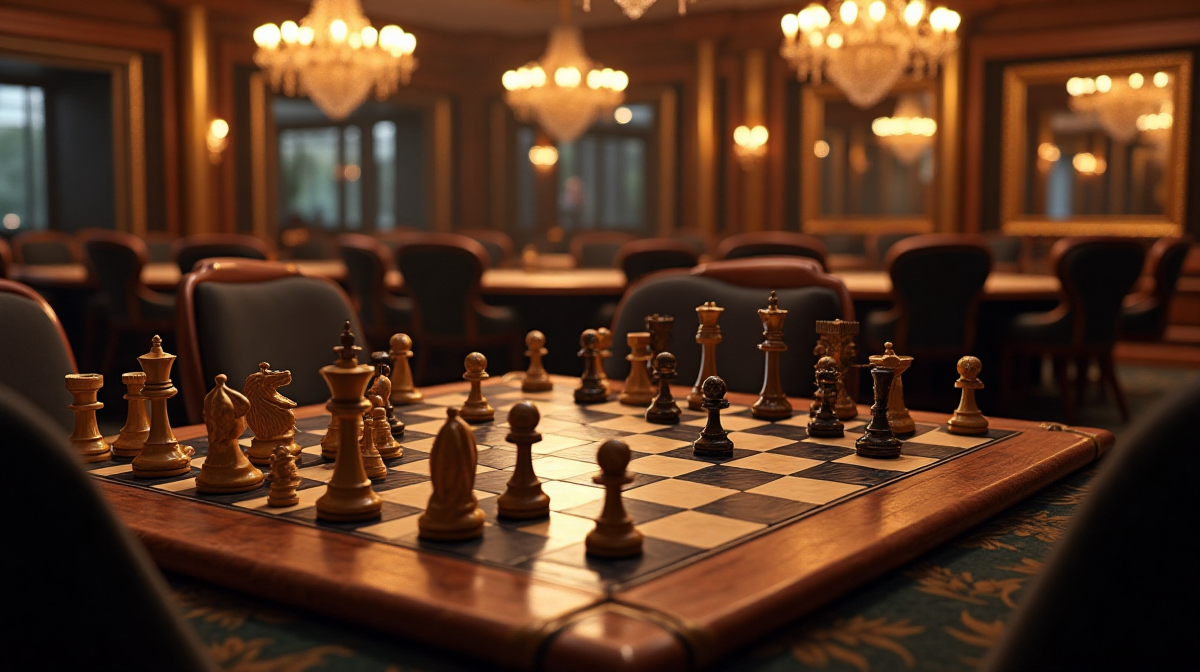Line Chess Strategy: Beginner's Guide
What is Line Chess?
Line Chess is a captivating variant of traditional chess, rapidly gaining popularity for its dynamic gameplay and strategic depth. The core concept revolves around connecting pieces along lines – horizontal, vertical, or diagonal – to create powerful formations and control the board. Unlike standard chess, capturing isn't always the immediate goal; controlling key lines and strategically positioning pieces are paramount. Many players are discovering the excitement of this game, and even exploring related entertainment options like пин ап for a bit of added fun.
Line Chess vs. Traditional Chess: Key Differences
While sharing a familial resemblance, Line Chess diverges significantly from its ancestor. The primary distinction lies in the emphasis on line control. In traditional chess, material advantage often dictates the outcome; in Line Chess, a strong line structure can overcome a material deficit. Movement rules are largely the same, but the strategic implications are vastly different. The availability of free chess resources online makes learning this variant incredibly accessible. Furthermore, the rise of online platforms offering diverse games – even those like пин-ап казино – reflects a growing appetite for novel gaming experiences.
Why Learn Line Chess?
Learning Line Chess offers several benefits. It sharpens strategic thinking, enhances pattern recognition, and promotes a deeper understanding of spatial relationships. It’s a refreshing challenge for seasoned chess players and an engaging entry point for beginners. The game’s focus on positioning and control fosters a different kind of tactical awareness. Many are finding that exploring diverse platforms, including those offering пин-ап это – a popular search term – broadens their gaming horizons.
Understanding the Board & Piece Movement
The Line Chess board is identical to a standard chessboard. Piece movement, for the most part, remains the same. Pawns move as they do in traditional chess, rooks move horizontally and vertically, bishops diagonally, knights in their L-shape, the queen in any direction, and the king one square in any direction. The key lies in how these movements contribute to establishing and maintaining strong lines.
The Importance of Lines & Connections
Lines represent power in Line Chess. Pieces connected along a line support each other and exert greater control over the board. Building unbroken lines is crucial for both attack and defense. A well-connected rook, for instance, becomes a formidable force.
Capturing & Controlling Territory
Capturing in Line Chess isn't always the primary objective. Often, controlling key lines and denying your opponent access to crucial squares is more valuable. However, capturing weak, isolated pieces is still advantageous. The strategic balance between territorial control and material gain is a key aspect of the game.
Basic Opening Strategies
Focus on developing pieces towards the center of the board and establishing connections. Avoid early queen development, as it can be vulnerable to attack. Prioritize controlling key diagonals and files. Many beginners explore resources offering free chess tutorials to help refine their opening strategies.
Common Beginner Mistakes to Avoid
Avoid isolating pieces, neglecting line connections, and blindly pursuing captures without considering the overall strategic implications. Don't underestimate the power of a well-placed rook.
Assessing Piece Strength in Line Chess
Piece strength is determined not only by its inherent capabilities but also by its connection to other pieces. A rook supported by pawns and other pieces is far more powerful than an isolated rook. Consider the lines a piece controls and its potential to participate in attacks or defensive formations.
The Role of the Rook
The rook is arguably the most powerful piece in Line Chess, especially when connected to other pieces along an open line. Its ability to control files and ranks makes it a potent attacking and defensive force.
Utilizing Bishops & Knights
Bishops excel at controlling long diagonals, while knights are effective at maneuvering around the board and creating forks. Positioning these pieces to support your lines is crucial.
Queen Strategy: Maximizing Influence
The queen is a versatile piece capable of controlling multiple lines simultaneously. Use it to support your attacks, defend key squares, and create threats. However, be mindful of its vulnerability to attack.
King Safety & Endgame Considerations
Protecting your king is paramount. Castle early to secure your king and connect your rooks. In the endgame, the king becomes a powerful attacking piece.

Forks & Pins – Exploiting Piece Weaknesses
Forks and pins are powerful tactical motifs. A fork attacks two pieces simultaneously, while a pin restricts the movement of a piece by threatening a more valuable piece behind it. Recognizing and exploiting these weaknesses can lead to material gains and positional advantages.
Lines of Attack: Creating Threats
Creating lines of attack allows you to focus your forces on a specific target. Coordinate your pieces along these lines to maximize their impact.
Sacrifices: When & Why to Give Up Material
Sacrifices can be powerful tools, but they must be carefully calculated. Sacrifice material to open lines of attack, disrupt your opponent's structure, or gain a decisive positional advantage.
Recognizing Tactical Opportunities
Develop your ability to scan the board for tactical motifs. Look for undefended pieces, weak squares, and potential lines of attack.
Defensive Tactics: Protecting Your Pieces
Protect your pieces by connecting them to others and controlling key squares. Be aware of potential threats and take steps to neutralize them.
Developing Your Pieces Effectively
Develop your pieces towards the center of the board and establish connections. Avoid blocking your own lines of attack.
Controlling Key Lines & Intersections
Controlling key lines and intersections gives you greater control over the board and restricts your opponent's movement.
Building Strategic Advantages
Focus on building strategic advantages such as space, mobility, and a strong line structure.
Recognizing Opponent’s Plans & Countering Them
Anticipate your opponent's plans and take steps to disrupt them. Be prepared to adapt your strategy as the game evolves. Sometimes a break from strategy with a game like пин-ап can refresh the mind.
Trading Pieces: When is it Beneficial?
Trading pieces can be beneficial if it improves your position, simplifies the game, or relieves pressure. However, avoid trading pieces if it weakens your structure or gives your opponent an advantage.
King & Pawn Endgames: Principles & Techniques
King and pawn endgames are often decided by subtle positional advantages. Focus on controlling key squares and promoting your pawns.
Rook Endgames: Active King & Rook Coordination
Rook endgames require active king and rook coordination. Use your rook to control open files and your king to support your pawns.
Endgame Principles: Opposition & Zugzwang
Understanding the principles of opposition and zugzwang is crucial for success in the endgame. Opposition allows you to control key squares, while zugzwang forces your opponent to make a disadvantageous move.
Simplifying to a Winning Endgame Position
Strive to simplify the game into a winning endgame position. Trade pieces to reduce the complexity and focus on your strategic advantages.
Recognizing Drawn Endgame Positions
Be aware of common drawn endgame positions, such as king and pawn versus king.
Prophylaxis: Preventing Opponent’s Plans
Prophylaxis involves anticipating your opponent's plans and taking steps to prevent them. This requires a deep understanding of the game and the ability to think ahead.
Exploiting Weaknesses in Opponent’s Line Structure
Identify and exploit weaknesses in your opponent's line structure. Attack isolated pieces, disrupt their connections, and create threats.
Piece Coordination & Synergy
Coordinate your pieces to maximize their effectiveness. Synergy occurs when pieces work together to achieve a common goal.
Strategic Planning & Long-Term Goals
Develop a long-term strategic plan and work towards achieving your goals. Be patient and persistent.
Understanding Common Line Chess Openings
Familiarize yourself with common Line Chess openings to gain a strategic advantage in the early game.
Online Line Chess Platforms & Communities
Numerous online platforms offer opportunities to play Line Chess against other players. Several communities also provide forums and resources for learning and improvement.

Recommended Books & Articles
Several books and articles delve into the intricacies of Line Chess strategy. Explore these resources to deepen your understanding of the game.
Practice Exercises & Puzzles
Solve practice exercises and puzzles to sharpen your tactical skills and improve your pattern recognition. Free chess puzzle sites can be particularly helpful.
Analyzing Your Games & Identifying Areas for Improvement
Analyze your games to identify your strengths and weaknesses. Learn from your mistakes and strive to improve your game.
Line Chess Tournaments & Competitions
Participate in Line Chess tournaments and competitions to test your skills and challenge yourself against other players. Even a short diversion with something like пин-ап can provide a mental reset before a tournament.

